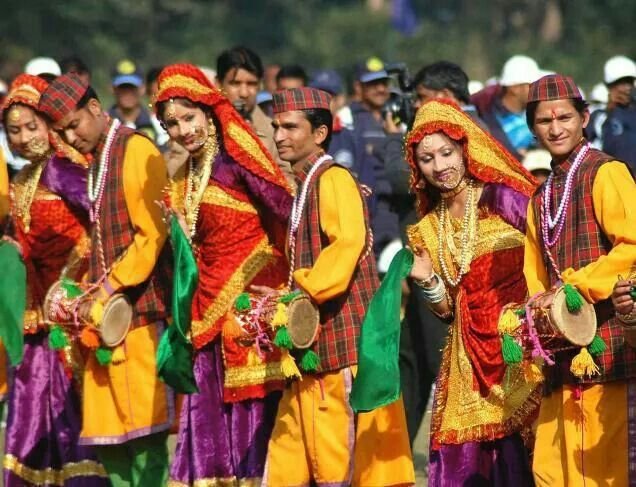
Nestled in the picturesque hills of Uttarakhand, Kumaon offers a fascinating snapshot of cultural fusion, richly laced with unmistakable Nepali influences. From the languages spoken in daily interactions to culinary delights served on bustling street corners, Kumaon reflects centuries of cross-border exchanges shaped by geography, history, and enduring traditions.
Historical Foundations
Shared Cultural Roots
Kumaon’s medieval history was closely intertwined with Nepal’s far-western Doti kingdom. Both regions, historically ruled by Katyuri and Doti dynasties, shared cultural patronage of Shaiva temples and folk ballads, which laid the groundwork for future exchanges.
Gorkha Influence
The transformative phase came in 1791 when the Gorkha Kingdom annexed Kumaon, ruling for 24 years. This period introduced Nepali administrative structures, military presence, and migrant settlers. Despite British forces pushing the Gorkhas back in 1815, many Nepali soldiers remained, establishing villages still evident in the hills of Pithoragarh and Champawat.
Language and Literature
Kumaoni, a prominent dialect of the Central Pahari group, shares significant linguistic traits with western Nepali (Doti). This linguistic proximity is seen in common vocabulary, pronunciation, proverbs, and idioms. Kumaoni literature often incorporates Nepali poetic meters and themes, a tradition dating back to oral exchanges across the porous Indo-Nepal border.
Everyday Kumaoni speech contains Nepali loanwords such as khana (to eat) and bholnu (to speak), clear evidence of sustained bilingual interactions over generations.
Festivals and Ritual Life
Festivals represent the heartbeat of Kumaoni-Nepali cultural integration, bridging communities through shared rituals and celebrations:
- Gaura Parva: Celebrated simultaneously in Nepal’s Sudurpaschim and Karnali provinces and Uttarakhand’s Pithoragarh and Almora districts, this festival features traditional Deuda dances and symbolic rituals like grass-string tying, embodying prayers for marital harmony.
- Harela: Widely observed across Kumaon and adjacent Nepali hills, Harela emphasizes ecological consciousness through tree-planting drives and symbolic barley planting rituals.
- Saton-Athon: Mirroring the Nepali Gaura rituals, Saton-Athon embodies a near-identical celebration of marital and agricultural prosperity.
Culinary Traditions and Commerce
The delicious scent of steamed momos and bowls of hearty thukpa waft through Kumaoni bazaars, a culinary legacy brought by Nepali migrants. This gastronomic adoption highlights the comfort and acceptance these dishes have found within Kumaoni daily life.
The annual Jauljibi fair, situated at the confluence of the Kali and Gori rivers, epitomizes cross-border commerce, where Nepali traders exchange wool, rock salt, and handicrafts for Indian staples like rice and jaggery, perpetuating a trading tradition established during the Gorkha era.
Tea estates in Champawat and Didihat continue hiring Nepali workers, ensuring continuous culinary and linguistic exchanges at the grassroots level.
Music, Dance, and Dress
Traditional dances like Kumaon’s Chholiya reflect significant Nepali influences, sharing choreographic elements with Nepal’s Chandi and Khukuri dances. These performances involve dynamic footwork, mock combat sequences, and rhythmic drumbeats.
The iconic nathuli nose-ring ornament worn by Kumaoni brides closely resembles its Nepali counterpart, highlighting shared cultural and social aesthetics stemming from common caste communities.
Border Migration and Demographic Exchanges
Sustained migration across the Indo-Nepal border ensures ongoing demographic intermingling. Nepalis frequently relocate westward to Kumaon for plantation work or army enlistments, while Kumaonis move eastward, seeking fertile farmland in Nepal’s Terai region.
Gurkha regiments established in Kumaon have maintained recruitment bases in Nepal, nurturing cultural exchanges through familial ties, pensions, and mutual visits.
Contemporary Cross-Border Dynamics
Institutional frameworks like the 1996 Mahakali Treaty facilitate effortless cross-border movement and commerce, formalizing longstanding informal practices. Modern infrastructure projects like India’s Bharatmala initiative and Nepal’s Strategic Road Network, particularly the Tanakpur–Darchula corridor, promise deeper cultural and economic integration.
Notably, the COVID-19 pandemic saw Kumaoni NGOs extending relief to neighboring Nepali districts, strengthening the communal sense of Himalayan solidarity.
Enduring Factors of Cultural Fusion
Several enduring factors have fostered this rich cultural symbiosis:
- Geographical Continuity: Open borders without natural barriers facilitate easy travel and exchanges.
- Historical Administration: The lasting legacy of direct Gorkha governance in administrative and military traditions.
- Inter-marriage: Common caste and familial ties frequently blur national distinctions, maintaining cultural coherence.
- Economic Complementarity: Mutual reliance ensures continuous social and economic interactions.
Conclusion
Kumaon’s vibrant cultural landscape, deeply enriched by Nepali influences, illustrates the profound interconnectivity fostered by history, geography, and socio-economic exchanges. From shared rituals to common cuisines, the everyday lives of Kumaonis reflect an ongoing dialogue with their Nepali neighbors, reaffirming the shared Himalayan heritage in a region shaped by unity rather than division.
FOR MORE BLOGS –beyondthepunchlines.com

 Add to favorites
Add to favorites







